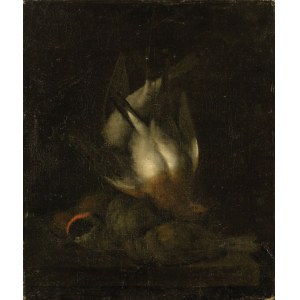BEARDED PTACT, 18th-19th c.
Oil, canvas, 38 x 32.5 cm
On the reverse, inscription in black paint: Eigethum des Grafen R. Anrep-Elmpt / auf Kerstenhof 1865.
On the stretcher inscription in black paint: JohanWeenix/ 1645-1719/75 No5.
State of preservation: painting after old conservation
The painting comes from the collection of Roman von Anrep. The von Anrep family originated in Westphalia. They resettled in the territory of today's Estonia and Latvia in the second half of the 15th century. - One of the family's representatives, Goswin (1470-1501), was a monastic knight. His sons started two strands - the Swedish and Livonian. The Livonian Anreps were Protestants, related to the Loewenwolde, Lieven, Keyserling, Budberg and Stael von Holstein families, among others. Another strand - descended from the Swedish captain Frederick Wilhelm von Anrep, who was taken prisoner by the Russians in 1710 - converted to Orthodoxy (from this strand came the famous mosaicist Boris Anrep (1883 - 1969), poet, member of the Bloomsbury group and friend of Anna Akhmatova). The featured painting was located in the von Anrep estate - Kerstenshof (now Kärstna in Estonia). The owner of the painting was Count Roman (Reinhold Filip Johann) Yosifovich Anrep-Elmpt (1834-1888). Born in Kursk Governorate, he was the son of General Josif (Carl Joseph) Romanovich Count Anrep-Elmpt and Cecilia von Elmpt. He grew up in Riga and was educated at the Cadet Corps in St. Petersburg. Participant in the Crimean War. Around 1870, he traveled around the world for more than eight years conducting ethnographic research. He visited the United States, India, Japan, South America, Africa, Egypt, Ceylon, the Caribbean, Hawaii, Java and Sumatra, and Australia (1878-83). The fruits of his travels became multi-volume works including Travels on the Five Continents, Journey through Australia. He died in 1888 in Burma of tropical fever. His grandfather, Roman Karlowicz (Reinhold Heinrich) (1757/1760 - 1807) von Anrep, was an alumnus of the Pazi Corps in St. Petersburg. He was awarded the Order of St. George, fourth class, for his participation in the war with Sweden in 1790. During the Polish-Russian War in 1792, he took part in the storming of Brest-Litovsk. During the Kosciuszko Uprising in 1794, he participated in the battle of Dubienka. He was awarded the Order of St. George, third class, for his attack on a detachment of Lithuanian troops in Ostrołęka. In 1801-1805 he was with his division in the Ionian islands and Naples. Subsequently, appointed to General Buxhoevden's Second Army, he commanded the division, participating in operations in northern Mazovia. During the Battle of Morag between Russian troops and the I Corps under Marshal Bernadotte - he was killed while preparing the retreat of General Markov's troops near the village of Plebania Wólka (there is a monument to his memory erected there to this day, founded in 1852 by his son Josif).
Per the opinion of Maria Kluk:
In an unspecified space, three beaten, small birds are depicted hanging with their heads down on a string tied to their feet. These birds are most likely partridges (Perdix perdix); they have light brown plumage, light ash on their bellies. Below them, on a stone tabletop, lie another three birds. One of them, possibly a woodcock (Scopolax rusticola) has a thin, rather long beak. On the left probably lies a woodpecker (Dryobates minor), with a distinctive red top of its head. This is the only vivid color accent in this very sedate, almost monochromatic composition. Still lifes depicting slaughtered birds (including domestic ones) as a distinct genre in Dutch painting appeared and flourished in the 1750s. The main centers where such works were created were Amsterdam, Utrecht and The Hague, and to a lesser extent Haarlem and Middelburg. At first they were modest compositions, with a small number of elements, balanced "spot" lighting and subdued colors. The leading representative of this trend was Elias Vonck (Amsterdam 1605-1652 Amsterdam). We know little about his education. Based on his achievements, we can infer that he was unfamiliar with the works of Frans Snyders (1579-1657) and Melchior de Hondecoeter (1636-1695). (...) It was the depictions of slaughtered fowl that became Vonck's specialty. In 1630 a son, John, was born to him, who became his pupil and a continuation of his style of painting, but little is known about his life except that his work was last recorded in 1666. Similar compositions soon appeared in the works of other masters. (...) The work in question was undoubtedly created under the influence of Elias Vonck's work. The simplicity of the composition, modesty of means of expression and almost monochromatic tonality bring a mood of tranquility and dignified solemnity. The designation of authorship given on the stretcher (Johan, or Jan Weenix) probably dates from the time of the creation of the collection's inventory (1875?) ( ).
Asking price 10000
Estimate 12000 - 15000
Recently viewed
Please log in to see lots list
Favourites
Please log in to see lots list









